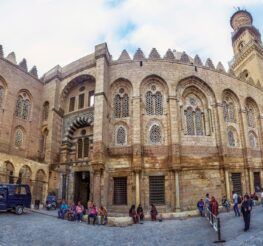Agricultural Museum: An Enlightening Lesson on Egyptian History

Hannah Cooper
For many, agricultural knowledge isn’t a necessary component for life in
the contemporary world; but for Egypt
and its historical Nile, it couldn’t be more
significant.
Despite the presumably boring context associated with its name, the Agricultural Museum
offers an intelligent and alternative insight into Egypt’s history. After all, wasn’t it thousands of years
ago that Egypt’s
Nile Delta provided the world with the most fertile of geographical areas?
Located on Wizaret El Ziraa Street in Dokki next to the
Ministry of Agriculture, the beige-stone walled-in complex isn’t difficult to
find. It wasn’t until the early 1930s that construction began on the chosen
palace grounds of Princess Fatma, daughter of Khedive Ismail. The museum
greeted its first guests nearly a decade later in 1938, becoming the first
agricultural museum to be built in the world.
Open Tuesday to Sunday from 9AM to 2PM; the Agricultural Museum
is truly one of the many historical gems in Cairo that remain under the radar. The expansive lawns provide a
lovely space for a sunny day walk, and seeing as how the complex is free of
pesky guards, reaching a state of relaxation isn’t difficult to achieve.
Surrounding the lawn, subsidiary museums are clearly
marked from the outside; but at the time of this reviewer’s visit, some were
closed for renovation including the Cotton
Museum and the Arab
Museum. While each building does indeed display Egypt’s history
through marks of agricultural growth, social and political connections can also
be found, providing an enlightening, circular history lesson. It is an
extensive amount of knowledge to be digested all in one sitting; so plan to
stay for awhile.
In the Building of Scientific Collections
in particular, the design and subsequent displays make for an oddly intriguing,
aesthetic experience. Filling each room with a strange yet alluring magic, mock
scenery depicting chronological phases of rural delta life include crafty,
detailed installations of pottery moulding and basket weaving. Don’t miss the
irrigation maps lining the wall and the photographic timeline of the Nile’s development; showing how this ancient symbol of life
has developed since its early birth.
Containing a variety of coloured graphs explaining breeding methods and
milling development, the Plant Growth Building
is right next door. As bread has played a prominent role in the
Egyptian diet since the time of the Pharaohs, it makes sense that a room is dedicated to its
progress. Rows of various types of bread are encased along one wall, while
intestinal diseases and dietary disorders are explained in the very same room; rather
unsettling but clever.
Also on the grounds of the museum are a cinema hall, lecture hall and library
as well as a laboratory for repairs, preservation, storing, embalming and
maintenance.
From the looks of it, the museum seems to be well taken care of;
conceptually on target, functioning properly and designed creatively. The
unexpected sense of wonderment surrounding this museum is worth a trip in and
of itself; so next time you’re up for an adventure, put a little agriculture on
your to-do list.
recommended
 Arts & Culture
Arts & Culture
The Coptic Museum: The History of Egypt to the Tunes of Psalms of David
arts & culture cairo museums +4 Health & Fitness
Health & Fitness
Egyptians in the 2024 Summer Olympics
Egyptians in the Olympics Olympics +1 City Life
City Life
Weekend Guide: Bazar by Sasson, Memo, The Cadillacs, Heya Bazaar, Dou, Nesma Herky & More
Concerts The Weekend Guide +2 Arts & Culture
Arts & Culture

